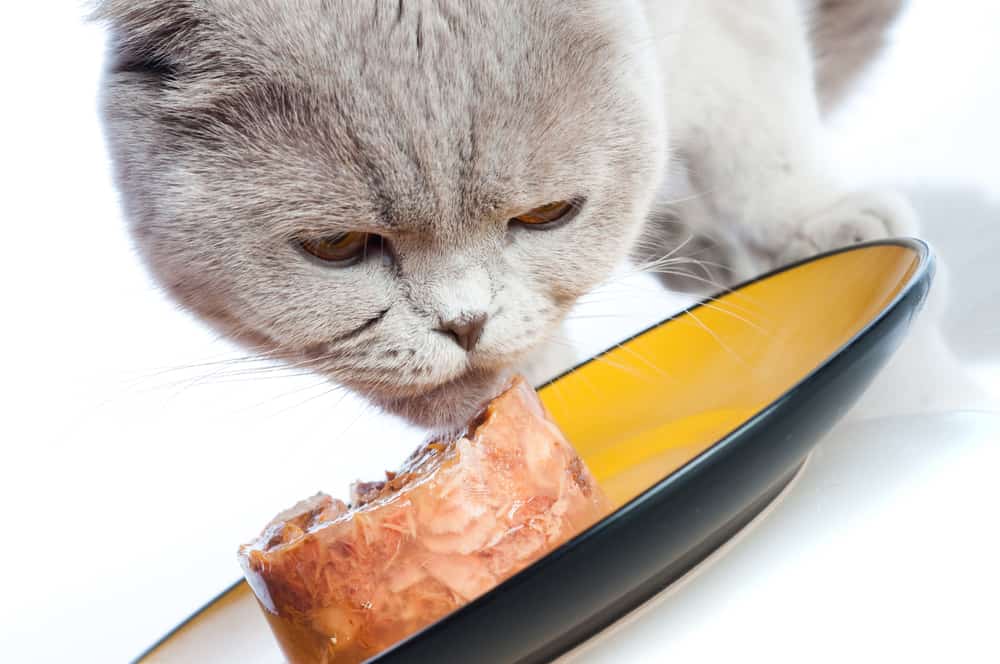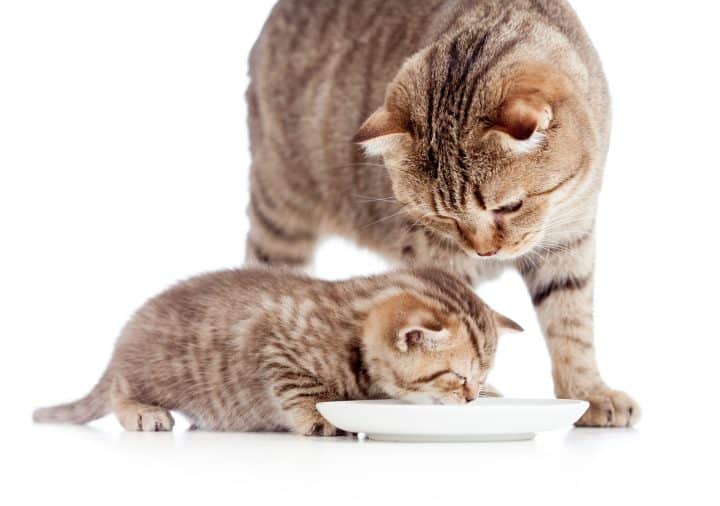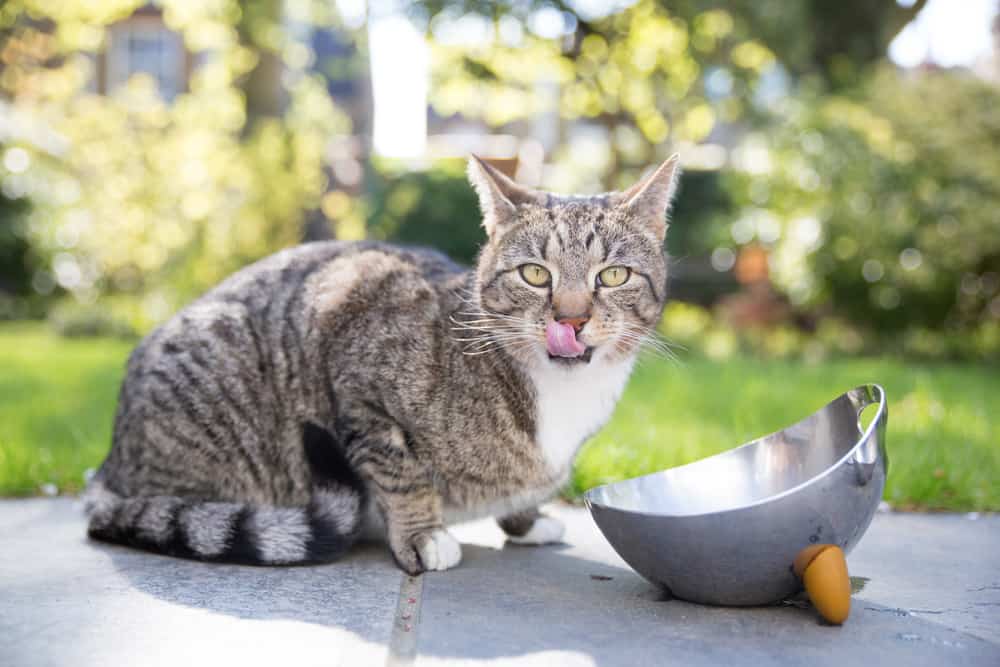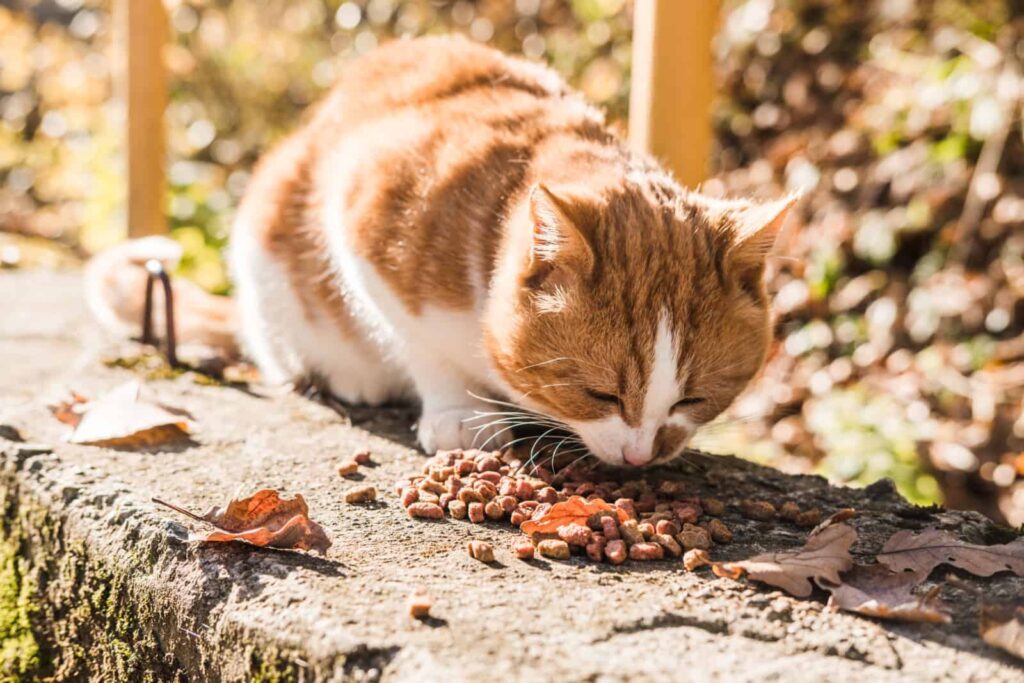Today we're going to do an in-depth review of Taste of the Wild cat food. We're going to look at 6 key categories including a deep dive into the list of ingredients, recall history, and more. This review is based on hours of research, real-world experience, and of course a love of cats!
Taste of the Wild has a reputation for being one of the more affordable cat foods on the market while keeping ingredient quality good but not great. It's a food I've frequently recommended across several of our lists as our best budget option.
Let's take a look at the big picture score for Taste of the Wild:
- Product Variety – 5/10
- Species Appropriateness – 6.5/10
- Ingredient Quality – 6.5/10
- Price – 8.5/10
- Marketing and Message Match – 5/10
- Recall History 5/10
- Overall Rating 6/10
The Story Behind Taste of the Wild Cat Food
1970 the brother-in-law duo of Gary Schell and Richard Kampeter started what was then called Meta Food and Grain. Like many pet food companies, they started with the goal of creating dog food and eventually expanded to cat food.
But the Meta Food and Grain name didn't last long. As the story goes, “a hunter who bought the new dog food said it made his dog’s coat shine like a diamond.”
That seemed to be all the inspiration they needed to drop the old name and go with Diamond Pet Foods which is the overarching brand behind Taste of the Wild along with many other brands.
Product Variety 5/10
With just two types of wet food flavors and only seven total cat food products, Taste of the Wild scores low in terms of product variety. In general, their focus seems to be on dry kibble over wet food which may work for some cat owners but two flavors won't be enough for many.
Taste of the Wild also uses a somewhat unconventional naming convention which I've personally found to be a little confusing. For example, instead of calling their diets, “Roasted Venison and Smoked Salmon” the name of the formula is “Rocky Mountain Feline Recipe.”
Now maybe I'm the only one, but seeing the Rocky Mountain or Canyon River doesn't tell me much so I want to break out the recipes offered by Taste of the Wild along with the main ingredients. Starting with the dry foods we have:
- Prey: Angus Beef Limited Ingredient Diet The Prey series does feature more obvious names for sure and as the name states this contains Angus beef.
- Prey: Turkey Limited Ingredient Diet As with the other prey formula, they do make the main protein clear
- Canyon River Feline Recipe (Wet & Dry) Focuses on trout and smoked salmon as the main protein sources
- Lowland Creek Feline Recipe Uses roasted quail and duck as the core protein sources
- Rocky Mountain Feline Recipe (Wet & Dry) Lists roasted venison and smoked salmon as main proteins
While Taste of the Wild does feature some more unique protein sources in form of Angus beef and venison, it's not enough to make up for the overall lack variety with only two wet food options.
Species Appropriateness – 6.5/10
When we talk about species-appropriateness we're talking about the most natural diet for your cat. Your cat is a carnivore.
But not just any carnivore.
Your cat is what's called an obligate carnivore which means they require meat in order to get all their nutrients. Besides chewing on some grass here and there, in a wild state, your cat wouldn't be eating any fruits or vegetables and all of their protein would be coming from animal-sources.
That means a cat food that scores high in terms of species-appropriateness is one that features animal proteins as prominent ingredients. Taste of the Wild does an okay job of this by featuring animal-sourced proteins as the first ingredients in all of their diets but in most cases, but their dry foods can be a little lacking.
For example, the Taste of the Wild Rocky Mountain recipe features peas, sweet potatoes, pea protein, and potato protein all within the first SIX ingredients. That means that roughly 66% of the first six ingredients are plant-based!
So how do they even deserve a 6.5 rating?
Simply having an animal-based protein as the first ingredient puts them far ahead of many lower-quality cat foods on the market (looking at you Meow Mix) but Taste of the Wild makes up a lot of ground with their wet food line.
If we look at the same recipe but in the wet food variety we see that ALL six of the first ingredients are animal-based:
Salmon, Fish Broth, Chicken Broth, Chicken Liver, Chicken, Dried Egg Whites
While some cat owners might not be impressed with two forms of broth here, it's part of the reasons why Taste of the Wild typically has a great price. Still, these are animal-based broths and they're must more species-appropriate than a carrot!
Overall, I think Taste of the Wild deserves a 6.5 out of 10 in terms of species-appropriate with the wet food options really bringing up that score.
Ingredient Quality – 6.5/10
While species-appropriateness and ingredient quality often go hand-in-hand, there are some other factors to consider when it comes to ingredients. Namely, thickening agents and additives that are easy to find in commercial cat food. Taste of the Wild does a solid job avoiding dangerous fillers and was included as our budget option on the list of best cat food without carrageenan.
However, the wet food recipes use guar gum and while I'm personally comfortable feeding my cat food with this additive (in small amounts) it's also something that many cat owners will want to avoid. You can learn a bit more about guar gum in cat food here.
Understanding Plant Proteins
While most Taste of the Wild recipes are high in protein (typically above 40% on a dry matter basis) much of this comes from plant proteins.
But are plant proteins bad?
Like many things in feline nutrition, there's plenty of debate but the fact is, plant proteins don't contain the same amino acid profile that you'd see in an animal-based protein. They're also clearly not as species-appropriate as animal sources of protein. But a recent study showed the cats are able to effectively digest plant proteins and I'd argue that protein plants are still much better than carbohydrates in cat food.
At the end of the day, it's a compromise. By adding more plant proteins, Taste of the Wild is able to keep overall protein content high while keeping prices affordable. This means that more cat owners will have better access to a higher caliber of food which I consider to be a good thing!
Proprietary Viables Probiotics
Taste of the Wild foods (both cat and dog) includes what they describe as “proprietary Viable Probiotics.” They go on to say that these are “species-specific probiotics” that help with digestive and immune health and that “each pound of Taste of the Wild provides 80 million live, active cultures that help support healthy digestive and immune systems.”
Probiotics have been found to improve the consistency of stools in cats, which is part of the reason why Taste of the Wild shows up on our list of the best cat food for smelly poops.
But it's still worth taking probiotic counts with a grain of salt. A 2003 study found that the advertised probiotics in pet food didn't actually match what was found in the food. However, any probiotics are better than no probiotics and I count Taste of the Wild's focus on probiotics as a positive!
Reviewing Ingredients
As I've already mentioned, there's a good deal of difference between the wet and dry varieties of Taste of the Wild recipes. So let's get a closer look at what's inside each recipe by reviewing three of the most popular products starting with their Angus beef recipe from their PREY line of dry kibble.
Ingredients in Taste of the Wild PREY Angus Beef Dry Kibble Formula (Limited Ingredient Diet)
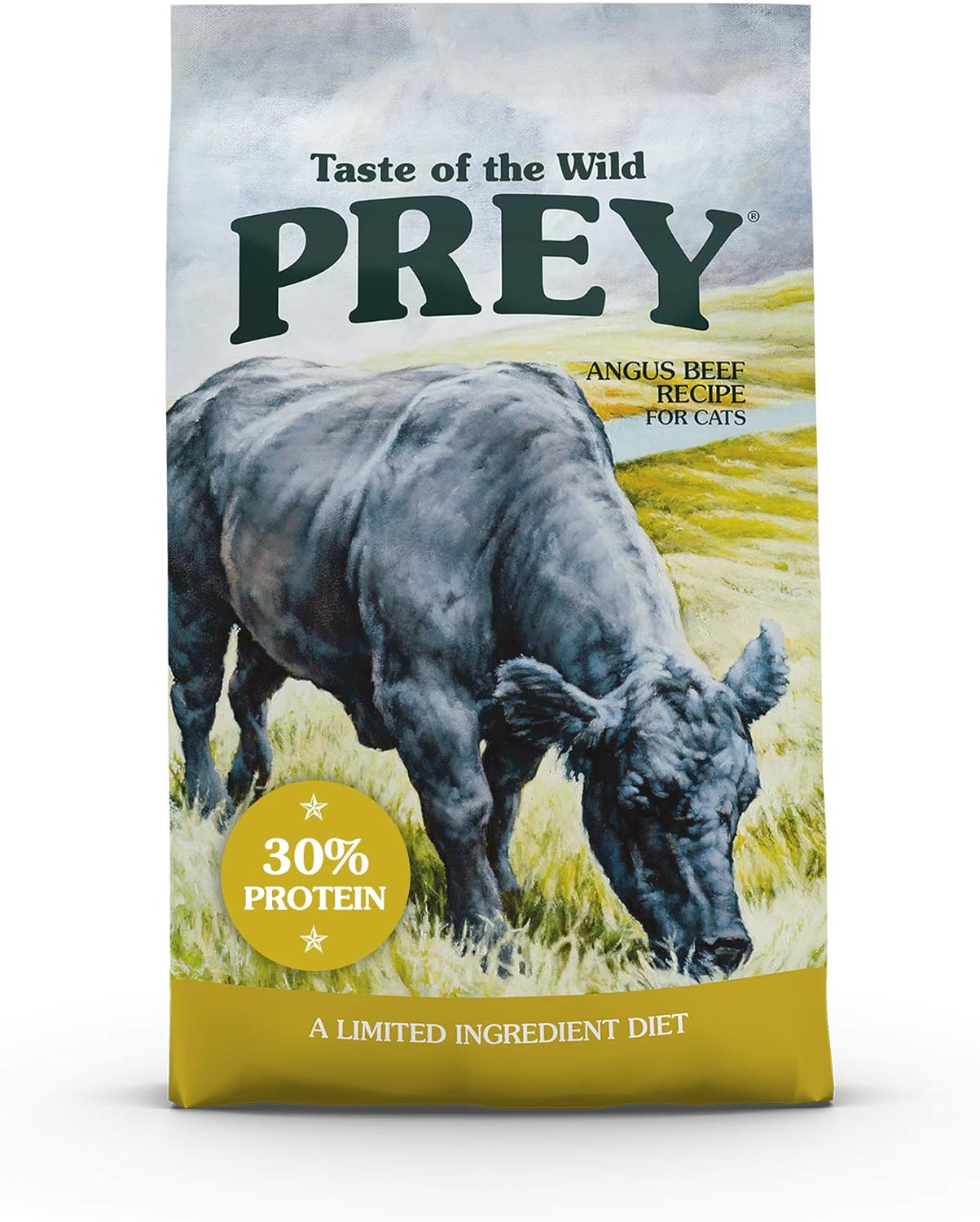
Taste of the Wild Prey Angus beef cat food
Angus beef, lentils, sunflower oil
Probiotics, vitamins, minerals
No by-products, GMOs, grains, artificial additives
Limited ingredients diets are designed to help cats with sensitive stomachs by limiting the variety of ingredients and sometimes adding a novel protein source. This dry kibble-only recipe features beef and lentils as the only protein sources and is definitely one of the more affordable limited ingredient diets on the market (you can check the latest price on Amazon by clicking here).
Taste of the Wild notes that this recipe has “55% of its protein from natural beef and 43% from wholesome lentils” which an important distinction. Check out the overview of plant proteins and a little further up this page if you haven't already and let's take a closer look at the first 5 ingredients.
1. Beef
Any food worth even considering feeding to your cat should have an animal-based protein as the first ingredient and there's no exception here. The American Association of Feed Officers tells us that when we see a named protein source like this it's “primarily the muscle tissue of the animal, but may include the fat, gristle and other tissues normally accompanying the muscle, similar to what you might see in a portion of raw meat sold for human consumption.”
We can't ask for much more in a first ingredient!
Overall, a high-quality ingredient.
2. Lentils
As the grain-free movement continues, we'll continue to see more peas and lentils in cat food. While peas, lentils, and similar plants are high in protein…they're still plants and they still contain more carbohydrates than any truly species-appropriate ingredient.
Including lentils as a prominent ingredient helps this recipe keep protein contents high while keeping costs down which may be an acceptable compromise for some cat owners.
3. Sunflower Oil
While sunflower oil is plant-based, it's still a good source of healthy fats. However, a feline study did show that it can't be considered a true substitute to fish oil in terms of providing fatty acids.
4. Natural Flavor
Natural flavor is simply flavor from a natural sources. There's no significant nutritional impact from natural flavors.
5. Salmon Oil
Salmon oil is an excellent ingredient. It's animal-based, which means it's also species-appropriate and provides a great source of omega-3 and omega-6 fatty acids.
Complete Ingredients and Guaranteed Analysis
Here's the complete list of ingredients for the PREY Angus beef recipe
Beef, Lentils, Sunflower Oil, Natural Flavor, Salmon Oil (Source Of Dha), Dl-Methionine, Salt, Potassium Chloride, Choline Chloride, Taurine, Dried Lactobacillus Plantarum Fermentation Product, Dried Bacillus Subtilis Fermentation Product, Dried Lactobacillus Acidophilus Fermentation Product, Dried Enterococcus Faecium Fermentation Product, Dried Bifidobacterium Animalis Fermentation Product, Zinc Proteinate, Vitamin E Supplement, Niacin, Manganese Proteinate, Copper Proteinate, Zinc Sulfate, Manganese Sulfate, Copper Sulfate, Thiamine Mononitrate, Vitamin A Supplement, Biotin, Potassium Iodide, Calcium Pantothenate, Riboflavin, Pyridoxine Hydrochloride, Vitamin B12 Supplement, Manganous Oxide, Sodium Selenite, Vitamin D Supplement, Folic Acid. Contains A Source Of Live (Viable), Naturally Occurring Microorganisms.
Here's the guaranteed analysis with moisture removed:
- 30% Protein
- 16.6% Fat
- 3.3% Fiber
Recipe Rating 4.5 / 10
While limited ingredient diets fill a very specific role, there's still plenty of room for improvement here. The primary issue is the inclusion of lentils as the second ingredient which means this diet has more carbohydrates than we'd want to see. Still, if you're looking for a very specific type of limited ingredient diet at an excellent price this might make the most sense to you. You may also be interested in Blue Buffalo's Limited Ingredient Diet and you can read my complete review here.
Ingredients in Taste of the Wild Lowland Creek Dry Kibble Recipe
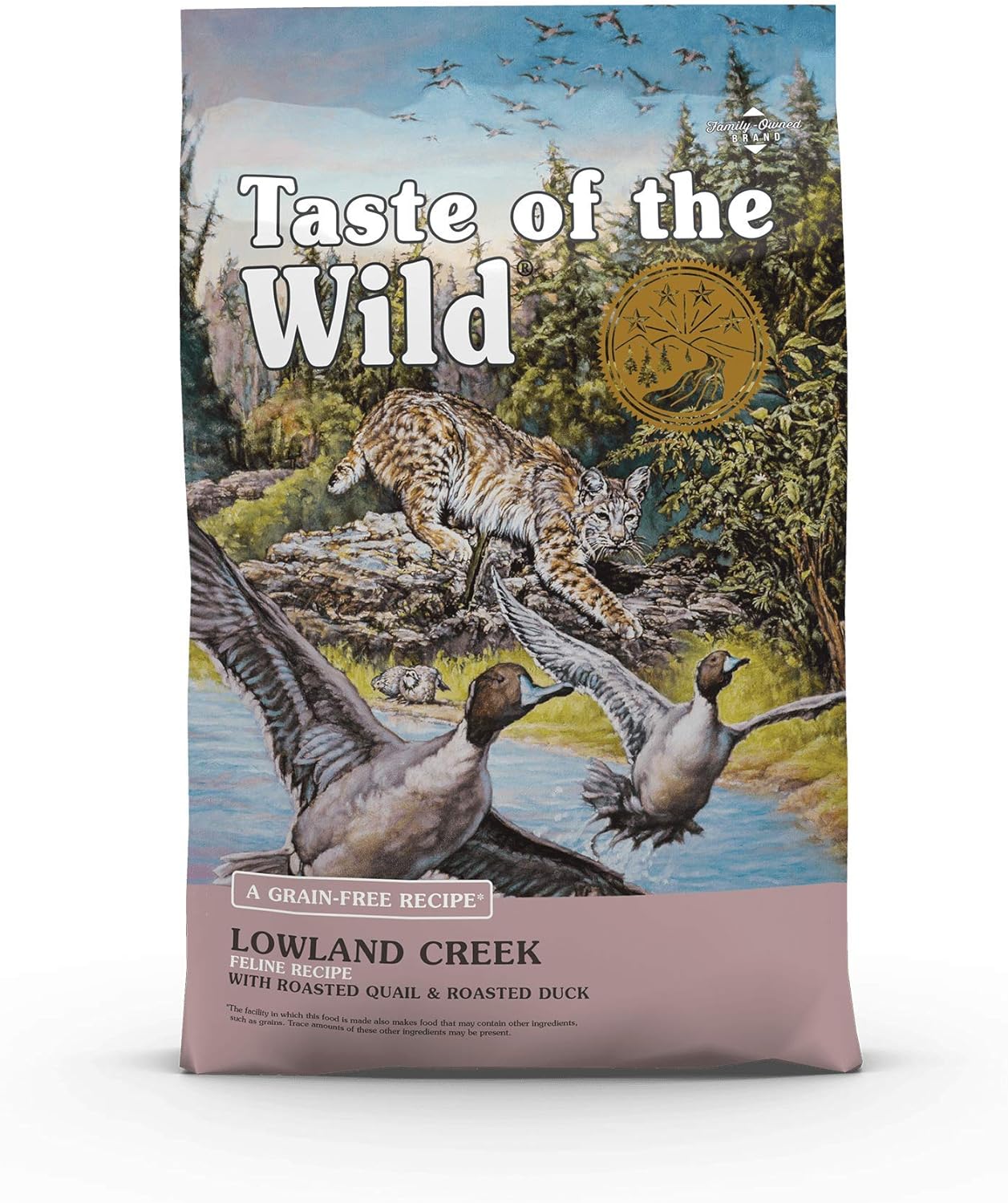
- High-quality protein for lean muscles
- Superfoods for antioxidants
- Fatty acid blend for skin and coat
- No grain, corn, wheat, or fillers
- No artificial flavors, colors, or preservatives
I decide to take a closer look at the Lowland Creek recipe instead of the more popular Rocky Mountain or Canyon River recipes because I think the Lowland Creek recipe has a higher-quality ingredient list while still staying budget-friendly.
Let's take a look:
1. Duck
As always, we want to see an animal-based protein in our number one ingredient. Similar to the previously mentioned beef, the AAFCO tells us that named poultry ” is the clean combination of flesh and skin with or without accompanying bone, derived from the parts or whole carcasses of poultry or a combination thereof, exclusive of feathers, heads, feet and entrails.”
That makes this an excellent first ingredient.
2. Duck Meal
When you see meal on a pet food label, it describes the meat after it's had fat and water removed and then ground down to a meal. While those fats and extra moisture could benefit your cat, using an animal-based meal adds a big boost to overall protein content.
3. Turkey Meal
Same as above but with turkey as the protein source.
4. Sweet Potatoes
Sweet potatoes are another ingredient that's gained a lot of traction in the era of grain-free diets and while they are grain-free they're still a carbohydrate which means they don't score well in terms of being species-appropriate.
5. Lentils
We see lentils showing up again but this time in ingredient number 5. While still a plant, lentils are a little higher in protein than most other veggies.
Complete Ingredients and Guaranteed Analysis
Here's the complete list of ingredients for the Lowland Creek recipe:
Duck, Duck Meal, Turkey Meal, Chicken Meal, Sweet Potatoes, Lentils, Peas, Chicken Fat (Preserved With Mixed Tocopherols), Roasted Quail, Roasted Duck, Natural Flavor, Salmon Oil, Dl-Methionine, Salt, Potassium Chloride, Choline Chloride, Taurine, Blueberries, Raspberries, Tomatoes, Dried Chicory Root, Dried Lactobacillus Plantarum Fermentation Product, Dried Bacillus Subtilis Fermentation Product, Dried Lactobacillus Acidophilus Fermentation Product, Dried Enterococcus Faecium Fermentation Product, Dried Bifidobacterium Animalis Fermentation Product, Zinc Proteinate, Vitamin E Supplement, Niacin, Manganese Proteinate, Copper Proteinate, Zinc Sulfate, Manganese Sulfate, Copper Sulfate, Thiamine Mononitrate (Source Of Vitamin B1), Vitamin A Supplement, Biotin, Potassium Iodide, Calcium Pantothenate, Riboflavin (Vitamin B2), Pyridoxine Hydrochloride (Source Of Vitamin B6), Vitamin B12 Supplement, Manganous Oxide, Sodium Selenite, Vitamin D Supplement, Folic Acid. Contains A Source Of Live (Viable), Naturally Occurring Microorganisms.
Here's the guaranteed analysis with moisture removed:
- 30% Protein
- 16.6% Fat
- 3.3% Fiber
Recipe Rating 6.5 / 10
With animal-based proteins making up the first three ingredients, the Lowland Creek recipe is much more species-appropriate than it's PREY counterpart all while keeping the price budget-friendly.
Ingredients in Taste of the Wild Rocky Mountain Recipe Wet Food

- Taste of the Wild Rocky Mountain with salmon and venison
- Supports bones, joints, and lean body
- Helps reduce carbs and increase hydration
- Includes peas, blueberries, and raspberries for nutrients
As I've already mentioned, there's a significant difference between the wet and dry varieties of Taste of the Wild so let's take a closer look at the Rocky Mountain wet food variety.
1. Salmon
As with all Taste of the Wild products, this recipe features an animal-based protein as the first ingredient. Salmon is not only species-appropriate, it's also a great source of healthy omega-3 and omega-6 fatty acids.
2. Fish Broth
Broth is a standard ingredient in wet cat food so it's no surprise to see here. While it doesn't add much in terms of nutrition, it's still technically species-appropriate.
3. Chicken Broth
While two types of broth in the first 5 ingredients is a bit much, it's moves like this that allow Taste of the Wild to keep the overall price down. Again, it's still species-appropriate at least to a degree.
4. Chicken Liver
Chicken liver is rich in nutrients (including vitamin A) and makes an excellent addition to this formula.
5. Chicken
I always like seeing more quality proteins within the top 5 and we've already covered how great named poultry is in terms of ingredients.
Complete Ingredients and Guaranteed Analysis
Here's the complete list of ingredients for the Rocky Mountain recipe:
Salmon, Fish Broth, Chicken Broth, Chicken Liver, Chicken, Dried Egg Whites, Potato Starch, Pea Flour, Smoked Salmon, Roasted Venison, Peas, Ocean Fish, Guar Gum, Natural Flavor, Sunflower Oil, Sodium Phosphate, Salt, Potassium Chloride, Inulin, Tomatoes, Blueberries, Raspberries, Taurine, Dl-Methionine, Choline Chloride, Iron Amino Acid Chelate, Zinc Amino Acid Chelate, Thiamine Mononitrate, Yucca Schidigera Extract, Vitamin E Supplement, Copper Amino Acid Chelate, Manganese Amino Acid Chelate, Sodium Selenite, Niacin Supplement, D-Calcium Pantothenate, Pyridoxine Hydrochloride, Riboflavin Supplement, Vitamin A Supplement, Biotin, Potassium Iodide, Vitamin D3 Supplement, Vitamin B12 Supplement, Folic Acid.
Here's the guaranteed analysis with moisture removed:
- 44.4% Protein
- 16.6% Fat
- 8.3% Fiber
Recipe Rating 7/ 10
Wet food is where Taste of the Wild really shines. Two types of broth help to keep the overall price of the product down, but we still get a 5 animal-based ingredient as ALL 5 of the first ingredients. This is certainly one of the better budget foods on the market and you can check the latest price on Amazon by clicking here.
Price 8.5/10
There's a reason that Taste of the Wild shows up on so many of our best-of lists in the “best on a budget” spot. All recipes are focused on packing in as much protein as possible and while there are more plant-based proteins it's part of keeping the price affordable. The two wet food options also do a great job of staying species-appropriate, again, especially at the price point.
With all that in mind, Taste of the Wild gets a very high and well-deserved 8.5 out of 10 when it comes to price. You can check the latest prices for all products Taste of the Wild cat food on Amazon by clicking here.
Marketing and Message Match 5/10
Taste of the Wild uses the same omnivore focused marketing that's so common in the cat food industry. For example, we know that fruits and veggies are an important part of our own nutrition so many cat owners will make the mistake that fruits and veggies are critical for our cat's health. But remember, cats are obligate carnivores and while antioxidants can benefit them, fruits and veggies aren't part of their natural diet.
Let's take a look at how this plays out with Taste of the Wild by reviewing a short blurb on their website:
Antioxidants – Vegetables and fruits, including sweet potatoes, tomatoes, blueberries and raspberries, provide nutrients that help promote your cat’s overall well-being, while guaranteed levels of zinc, selenium and vitamin E help support the immune system.
Again, antioxidants can be of benefit to your cat but a wide range of fruits and veggies is not something your cat needs.
If we look at the PREY Angus beef recipe we see that they describe lentils as “A superfood packed with protein, fiber, complex carbohydrates, and essential nutrients.” This isn't false but it does imply that your cat needs carbohydrates. But as Dr. Claudia Kirk points out in this article, “No requirement for dietary carbohydrates has been demonstrated for adult cats.” Dr. Kirk goes on to say that many carbohydrate-rich dry cat foods are still well-tolerated by cats.
There's also the issue of product names. If we look at the Rocky Mountain Feline Recipe it states, “with Roasted Venison & Smoked Salmon”. While the FDA has very clear rules on this, it may surprise some pet owners to find that the recipe only needs to contain 3% of the featured ingredient to describe the recipe as “with”.
Based on the name alone, some cat owners might assume that the Rocky Mountain recipe primary features salmon or venison but we don't see either one until ingredient number seven.
Taste of the Wild is certainly not alone in using either of these strategies and no rules are being broken but it does make the cat food space that much more confusing to navigate and it also means that I can't give Taste of the Wild more than a 5 out of 10 in this category.
Recall History 5/10
Taste of the Wild has one major recall that occurred in 2012 after several units tested positive for salmonella. You can read the entire press release here. But to get a full picture of recalls it's worth looking at the recall history for not only Taste of the Wild but also the parent company behind the brand, Diamond Pet Food.
While Taste of the Wild has only one recall, Diamond Pet Food has several more with the most serious issue occurring in December 2005 when a string of tragic pet deaths was found to be related to aflatoxin.
Sadly, recalls happen and not just in the pet food industry but across human food, too.
Overall, the specific Taste of the Wild brand has a reasonable recall history but when we look at the manufacturing company behind the brand we uncover a few more recalls which earns them a rather low 5 out of 10 in this category.
Online Reviews Of Taste of the Wild
After spending hours digging around all corners of the internet (including forums, blogs, and of course vendor websites) I've come up with a general feel for what the internet reviews have to say about Taste of the Wild.
There's plenty of reviews out there but let's start with what cat owners like.
What Cat Owners Like
Many cat owners mention the high-protein and grain-free content of the food, which is a BIG improvement if you're coming from a really low-quality food like Meow Mix. Here's one my favorite reviews from Amazon:
Since she was a kitten Daisy has only had (and only liked) the generic brand grocery store wet & dry food from Coles (Australia). That or Meow Mix. She got a small infection and her vet recommended we try a healthier cat food, so after reading tons of reviews I decided to try this one.
She did NOT immediately like it at all! I mixed in small amounts with her Meow Mix, increasing the ratio over a period of several weeks or so (took about a month+) before she really got accustomed to it. Now, she prefers this over her wet food!
A friend put it as “Alanna, if you only fed your child McDonalds growing up, she’s not immediately going to like a salad.” I love knowing she’s healthy with a great quality food now, that she loves! She hasn’t gained/lost a significant amount of weight, but she’s just nice and healthy now. Never doing Meow Mix again.
Just about every cat food has HUNDREDS of cat owners complaining that their cat didn't like the food and I love that this cat owner took the time to properly transition to new food!
Here's another review from a happy cat owner that's emphasizing the protein aspects of the recipe:
I was looking for a highly nutritious, grain-free, high-protein formula cat food for my Maine Coons, since they need the extra protein to ensure their larger muscle mass is taken care of well as they age. THIS is it. They LOVE it and both are super lean and their muscles are well defined, as they should be. Taste of the Wild is a great product. Highly recommend.
What Cat Owners Don't Like
As with many cat foods, most of the one-star reviews come from cats that refused to eat the food. There are a handful of reviews that suggest the formula changed but I wasn't able to find any evidence to support that.
Interpreting Reviews
Overall, the majority of reviews are positive and most cat owners are happy with the high-protein content (even if some of it is from plants). The negative reviews are primarily focused around cats that just didn't want the food but there does seem to be a trend over the last year of suspicions that the recipe has changed but I couldn't' find any support for that claim.
My Overall Rating 6/10
I'm giving Taste of the Wild cat food an overall rating of 6/10 but it's worth noting that the wet food outperforms the dry kibble and I'd generally just avoid the limited ingredient diets because of their overreliance on plant protein.
Despite its issues, Taste of the Wild still makes a great budget option for many cat owners and is a big step up from your typical drug store brand of cat food.
If you'd prefer a more premium cat food that's also focused on protein, check out my review of Dr. Elsey’s cleanprotein brand cat food here.


